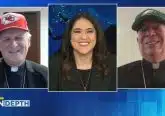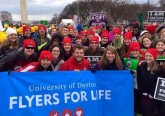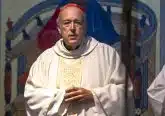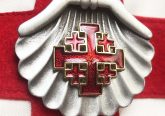13 things to know about J.D. Vance’s Catholic journey
National Catholic Register, Jul 21, 2024 / 07:00 am
Republican vice presidential nominee J.D. Vance is one of the most overtly religious major politicians in America.
Vance has written extensively about his life in faith, both in a mega-selling memoir and in a long essay that describes how a drug-using teenager with anger problems, family problems, school problems, and doubts about God became an accomplished, successful family man excited about being a Catholic.
But nowadays, he’s also the most questioned of religious politicians, as pro-lifers ask if he’s still one of them.
Where did he come from in faith? And how did he get where he is now?
Vance, who comes from a long line of culturally Protestant Scots-Irish Americans from Appalachia, was baptized Catholic in August 2019.
Below are 13 items about his meandering journey to Rome and the aftermath, drawn largely from his 3-million-copy-selling 2016 memoir “Hillbilly Elegy” and a 6,777-word essay he wrote about his conversion for the Easter 2020 issue of The Lamp, a Catholic magazine.
Vance also talked about his conversion in an August 2019 interview with Rod Dreher published in The American Conservative.
1. J.D. Vance rarely went to church as a child.
Vance was largely raised by his grandmother, whom he called “Mamaw,” who believed in Jesus and liked Billy Graham but didn’t like what she called “organized religion.”
Vance wasn’t baptized as a child. The family members he spent the most time around generally didn’t go to church unless they were visiting their Appalachian ancestral home in Jackson, Kentucky.
Even so, he says in his memoir, his grandmother had “a deeply personal (albeit quirky) faith.”
2. Vance had a crisis of faith as a child.
When he was about 10, Vance had a moment of doubt.
“Mamaw, does God love us?” he asked his grandmother after a major disappointment, mindful of the fractured family life he and his half-sister were growing up in.
The question caused his grandmother to cry.
Vance doesn’t say how his grandmother answered the question. But he describes another instance when Mamaw accidentally went the wrong way on a three-lane interstate before making a U-turn, causing him to scream in terror.
“Don’t you know Jesus rides in the car with me?” his grandmother replied.
3. As a teenager, Vance was a Pentecostal.
As an adolescent, Vance reconnected with his biological father, whom he hadn’t seen much of after his parents split up. For a while, he stayed with his dad every other weekend.
“With little religious training, I was desperate for some exposure to a real church,” Vance wrote in “Hillbilly Elegy.”
His father had given up drinking and became a serious Pentecostal, and he would take Vance to a large Pentecostal church in southeastern Ohio with his new wife and their children.
Vance drank it in. Among other things, he rejected evolution and embraced millennialism, including a belief that the world would end in 2007.
“I’m not sure if I liked the structure or if I just wanted to share in something that was important to him — both, I suppose — but I became a devoted convert,” Vance writes in his memoir.
4. Vance didn’t like the Catholic Church when he was a kid.
Even before he started going to a Pentecostal church, Vance thought he knew certain things about Catholicism — which he didn’t like.
“I knew that Catholics worshipped Mary. I knew they rejected the legitimacy of Scripture. And I knew that the Antichrist — or at least, the Antichrist’s spiritual adviser — would be a Catholic,” Vance wrote in his April 2020 article in The Lamp of his once-misguided impressions.
5. Vance’s image of Jesus when he was growing up differed from his image of the Catholic Church’s image of Jesus.
One of Vance’s aunts married a Catholic, whom Vance liked and respected.
“I admired my uncle Dan above all other men …,” Vance wrote in “Hillbilly Elegy.”
His grandmother liked Dan, too.
But Catholicism seemed too formal and impersonal to her.
“The Catholic Jesus was a majestic deity, and we had little interest in majestic deities because we weren’t a majestic people,” Vance wrote in his conversion essay.
6. “Hillbilly Elegy” isn’t a conversion story.
Vance mentions the word “Catholic” or “Catholics” only five times in the 264-page book, and he never engages with Catholic teachings in it. He wrote it between 2013 and 2015, several years before he became a Catholic, and gives no hint that he had ever considered Catholicism.
He also doesn’t dwell in his book on his atheism as a young man, a period he describes at length in his conversion essay in The Lamp.
7. An Anglican philosopher provided the first crack in Vance’s atheism.
While he was still a nonbeliever, Vance encountered the work of English philosopher Basil Mitchell (1917–2011) in an undergraduate philosophy course at Ohio State.
As Vance describes it, Mitchell, who was a member of the Church of England, presented difficult experiences in life as a trial of faith that requires trust in God without fully understanding what God has in mind.
Vance was surprised by Mitchell’s presentation because as a young Christian he had always thought that “[d]oubt was unacceptable” and “that the proper response to a trial of faith was to suppress it and pretend it never happened.”
“But here was Mitchell,” Vance wrote in his conversion essay, “conceding that the brokenness of the world and our individual tribulations did, in fact, count against the existence of God. But not definitively.”
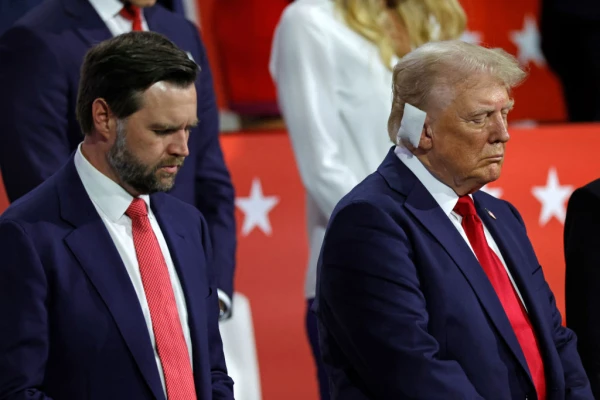
8. A homosexual billionaire influenced Vance’s outlook on life.
While a student at Yale Law School, Vance went to a talk by venture capitalist Peter Thiel, who was Facebook’s first outside investor and co-founded PayPal.
According to Vance, Thiel argued that elite professionals got themselves trapped into climbing rungs on the socioeconomic ladder at the expense of happiness.
Vance realized that he was “obsessed with achievement” for itself — “not as an end to something meaningful, but to win a social competition.” He also concluded that he “had prioritized striving over character.”
Thiel introduced Vance to the thought of René Girard (1923-2015), a French historian and philosopher whose writings, among other things, attracted Vance through the way he described Christianity as transcending the scapegoat myth of various cultures because Christ “has not wronged the civilization; the civilization has wronged him.”
Thiel, now 56, who identifies as a Christian and a conservative, is civilly married to a man. Vance worked for Thiel in venture capital, and Thiel was Vance’s major contributor in Vance’s successful run for U.S. Senate in Ohio in 2022.
9. Vance’s family ties kept him from becoming a Catholic for a long time.
Vance connected with Catholic doctrine several years after his grandmother died in 2005. It made sense to him.
“Yet I couldn’t shake the feeling that if I converted I would no longer be my grandmother’s grandson,” Vance wrote in The Lamp.
That left him in a sort of limbo.
“So for many years I occupied the uncomfortable territory between curiosity about Catholicism and mistrust,” he wrote.
10. Vance credits his Hindu wife with helping him convert to Catholicism.
Vance acknowledges having problems with anger stemming from his chaotic childhood and the destructive behavior of people in his family, especially his mother, who abused prescription drugs and went through a string of boyfriends and husbands.
That anger affected his relationship with Usha, his girlfriend in law school, but she helped him work through it to try to become the kind of husband and father he wanted to be. They married in 2014.
“The sad fact is that I couldn’t do it without Usha. Even at my best, I’m a delayed explosion — I can be defused, but only with skill and precision,” Vance wrote in “Hillbilly Elegy.”
Usha is the daughter of immigrants from India and a Hindu. Vance felt hesitant about joining the Catholic Church because he wasn’t a Catholic when they got married.
“But from the beginning, she supported my decision, so I can’t blame the delay on her,” Vance wrote in his conversion essay.
Vance has said the Church’s clergy sex-abuse scandal delayed his conversion by a few months.
11. Dominican priests helped draw Vance to Catholicism.
What Vance calls “a few informal conversations with a couple of Dominican friars” led to a period of serious study of Catholicism.
The process was gradual, with no a-ha moments.
But it included what he calls “some weird coincidences.”
During a late-night conversation at a hotel bar with an unnamed conservative Catholic writer, Vance says, he challenged the man for criticizing Pope Francis.
“While he admitted that some Catholics went too far, he defended his more measured approach,” Vance wrote in his conversion essay, “when suddenly a wine glass seemed to leap from a stable place behind the bar and crashed on the floor in front of us.”
That ended the conversation.
Another: While on a train from New York to Washington, D.C., Vance listened to a recording of an Orthodox choir singing a Psalm during Pope Francis’ visit to the country of Georgia in 2016.
When he got to Washington, he asked a Dominican friar to coffee.
“He invited me to visit his community, where I heard the friars chanting, apparently, the same psalm,” Vance wrote.
Vance was baptized in August 2019 by a Dominican priest, Father Henry Stephan, at St. Gertrude Priory, which is attached to a Dominican parish in Cincinnati, where Vance now lives.
Despite his Dominican connections, his confirmation saint is Augustine.
“I was pretty moved by the ‘Confessions,’” he told Rod Dreher. “I’ve probably read it in bits and pieces twice over the past 15 or so years. There’s a chapter from ‘The City of God’ that’s incredibly relevant now that I’m thinking about policy. There’s just a way that Augustine is an incredibly powerful advocate for the things that the Church believes. And one of the subtexts about my return to Christianity is that I had come from a world that wasn’t super-intellectual about the Christian faith. I spend a lot of my time these days among a lot of intellectual people who aren’t Christian. Augustine gave me a way to understand Christian faith in a strongly intellectual way. I also went through an angry atheist phase. As someone who spent a lot of his life buying into the lie that you had to be stupid to be a Christian, Augustine really demonstrated in a moving way that that’s not true.”
12. Vance credits practicing Catholicism with making him a better person.
Vance says practicing his Catholic faith has helped him increase his patience, curb his temper, forgive more easily, and choose his family over his career.
After he became a Catholic, Vance wrote in his conversion essay: “I realized that there was a part of me — the best part — that took its cues from Catholicism.”
13. Vance hasn’t yet explained how his current position on abortion squares with his Catholic faith.
Vance began public life as thoroughly pro-life.
In September 2021, several months after he began running for U.S. Senate in Ohio, Vance said he supported Texas’ law banning abortion.
“I think in Texas they’re trying to make it easier for unborn babies to be born,” Vance said during an interview with Spectrum News 1.
Asked about abortion in the cases of rape and incest, Vance said the question is “whether a child should be allowed to live.”
“Look, I think two wrongs don’t make a right. At the end of the day, we’re talking about an unborn baby,” Vance said (at 11:11 of the interview). “What kind of society do we want to have? A society that looks at unborn babies as inconveniences to be discarded?”
His tone shifted during a debate in October 2022 when he said he supported “reasonable exceptions,” including allowing a pregnant 10-year-old girl to have an abortion.
During a second debate that month, he said he supported a proposal in Congress at the time that would have banned abortion nationwide after 15 weeks.
More recently, Vance has aligned his public positions on abortion with those of his running mate, former president Donald Trump, who has said he wouldn’t sign a federal limitation on abortion and that he wouldn’t ban abortion pills.
On abortion pills, Vance told an interviewer on NBC on July 7 that he supports a recent U.S. Supreme Court decision that, according to him, said that “the American people should have access to that medication.” Pressed about mifepristone, one of the two abortion chemicals, he said he supports access to it.
Vance has not at this writing publicly explained how he integrates his Catholic faith with his current position on abortion.
But he seemed to contemplate this sort of situation in an interview with Dreher in August 2019, shortly after his conversion and three years before he was elected to public office.
He noted that politics “is in part a popularity contest,” and he pointed out a tension between getting votes and living a life of faith.
“When you’re trying to do things that make you liked by as many people as possible, you’re not likely to do things that are consistent with the teachings of the Catholic Church,” Vance said then. “I’m a Christian, and a conservative, and a Republican, so I have definite views about what that means. But you have to be humble and realize that politics are essentially a temporal game.”
This story was first published by the National Catholic Register, CNA’s sister news partner, and has been adapted by CNA.










